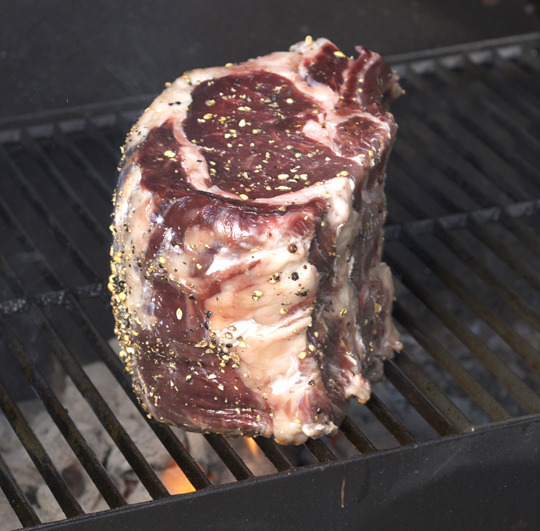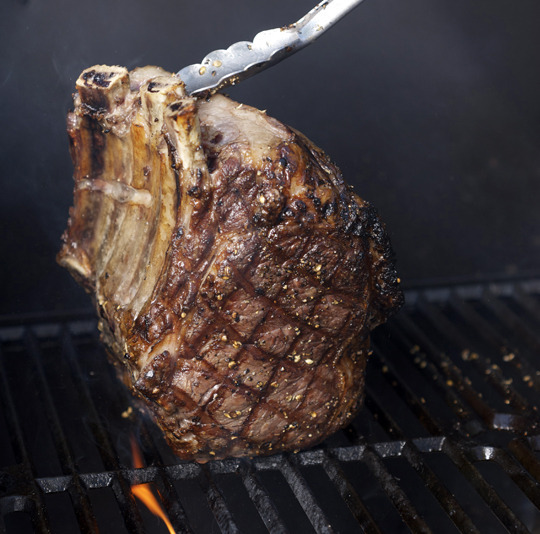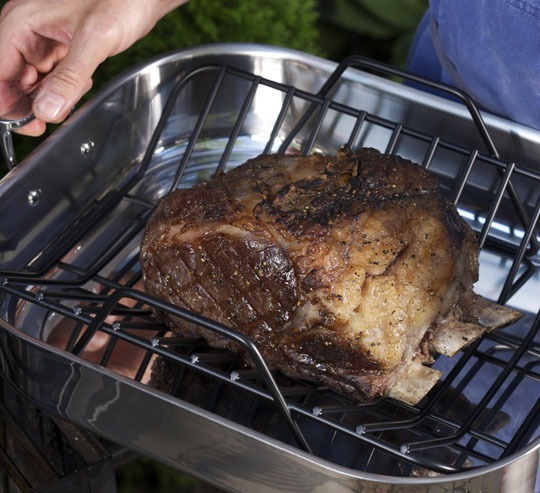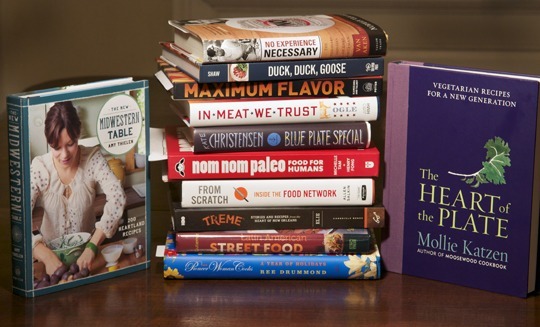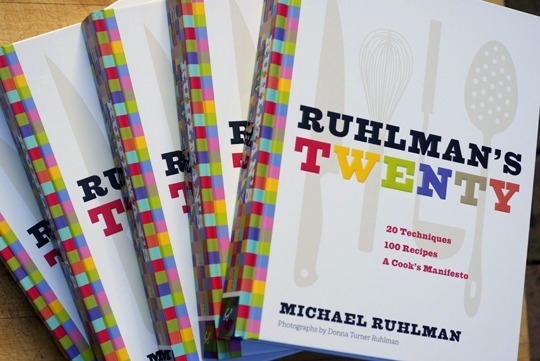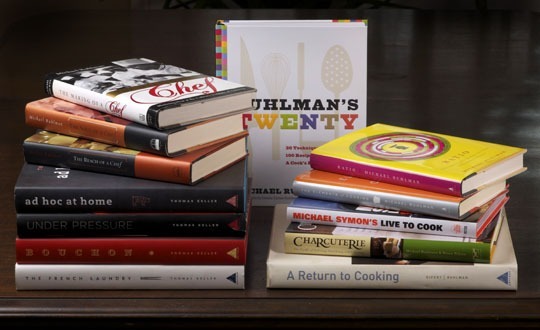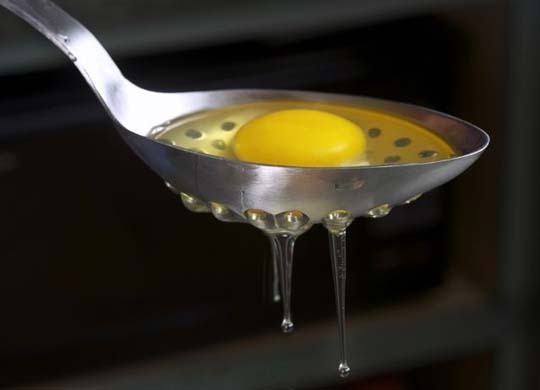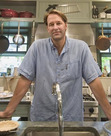Michael Ruhlman's Blog, page 32
December 16, 2013
Holiday Classics: Rib Roast

Roast beef mise en place. Photo by Donna Turner Ruhlman.
Reposting this method from last year because, well, if you’re going to cook a standing rib roast now or ever, this is THE best way to do it. Every Christmas Day our family cooks a prime rib with Yorkshire pudding and a beef jus (made from beef-veal stock), and there’s no better way to cook a rack of beef or a whole beef tenderloin than this combination grill-roast method, which I’ve written about here before and in Ruhlman’s Twenty: A Cook’s Manifesto. It gives the meat great grilled flavor and allows you perfect control of temperatures and timing (the grilling can be done up to three days before the final cooking).
The ribs themselves are an added benefit. You can serve them immediately, but I like to save them for a second leftover meal the next day. They’re delicious spread with some Dijon mustard and bread crumbs, cayenne if you like it hot, then broiled. When ordering the roast, I plan on 1 pound/450 grams per person, which is usually enough to have leftovers.
This method must be done on a charcoal grill. Gas grills give you nothing but flame-ups and bitter black smoke. The meat is first seared over high heat, then moved to the cool side of the grill and covered so that it’s smoke-roasted. It’s then put in an oven and brought to a temperature between 120˚F/50˚C and 125˚F/52˚C if you want it rare. I then crank the oven for the Yorkshire pudding (poured right into the roasting pan or into popover molds). The beef will rest for 30 minutes while you finish the meal. See below for carving info.
It’s a great way to serve this special cut of beef to a big group and enjoy yourself in the process.
Pre-holiday days can be stressful; plan ahead to reduce the stress, and enjoy what should be happy days with friends and family. Happy holidays to all!
Grilled and Roasted Beef
One 6-pound/2.7-kilogram rack of beef
2 to 3 tablespoons kosher salt
2 tablespoons canola or olive oil
2 teaspoons coarsely cracked black pepper
2 teaspoons coarsely cracked coriander seeds
Rinse the beef and pat it dry. Line an appropriately sized baking sheet or platter with paper towels. Liberally sprinkle the beef all over with the kosher salt. You should have a nice crust of salt on the exterior. This is best done several days before cooking; refrigerate the beef, uncovered, until the day you cook it.
Remove the beef from the refrigerator 3 to 4 hours before grilling. Rub the beef with the oil and sprinkle all sides with the pepper and the coriander.
Grilling off the sides of the roast. I’ll add more pepper and coriander next time!
Build a hot fire in one half of the grill (you’ll be searing all sides of the rack of beef first). Spread the coals out, put an oiled grill rack over them, and allow it to get hot. Put the beef on the rack over the coals, and cover. Sear it on all sides (covering will keep more smoke on the meat and reduce the flames from the rendering fat). When all sides are seared, a few minutes on each side, move the roast to the cool side of the grill cover and cook another 10 minutes.
Achieving some beautiful grill marks.
If you’re serving the beef immediately, preheat the oven to 250°F/120°C. Put the beef on a rack in a roasting pan or on a baking sheet and roast it to an internal temperature of 125°F/52°C for rare or 130°F/54°C for medium-rare. This will take 15 to 20 minutes per pound, but can vary depending on the internal temperature of the meat when you began cooking it. I recommend a cable thermometer; I use my RediCheck or the cool new iGrill, both of which sound an alarm when it hits the desired temperature (the iGrill also sends the temperature to my iPhone!). This way, I can talk to family, enjoy myself completely, and forget about the meat till it’s ready.
If you’re cooking the beef ahead of time, refrigerate it after grilling and cooling, then cover with plastic wrap and refrigerate it. To finish it, let it sit at room temperature for 4 hours or so before putting it in the oven. It should take 15 minutes per pound at this point. If you’re grilling and roasting on the same day, it can be taken straight from the grill and left at room temperature until you’re ready to roast it.
All done grilling and now to finish off cooking in the oven.
Allow the meat to rest for 30 minutes at room temperature after you remove it from the oven.
Checking the internal temperature of the roast.
Remove the beef loin from the ribs, slicing along the ribs downward to remove the loin in one piece. It’s best to do this on a carving board with a moat, or channel, around the periphery. The beef will release a lot of juice, which can be spooned over the meat when serving. Slice the meat as desired. If you wish to serve whole pieces on the bone, simply slice them whole and serve with the juices.
Serves 6
If you enjoyed this post check out these links
My past post for the holiday season are roast braise turkey or Spatchcocked Grilled Turkey.
Roasted cauliflower from Twenty is a great addition to your holiday dinner.
Shop for heritage meats for your holiday table from Heritage Foods USA.
The Meadow is Mark Bitterman’s shop in Portland that specializes in salts and other handcrafted products.
© 2013 Michael Ruhlman. Photo © 2013 Donna Turner Ruhlman. All rights reserved.
December 13, 2013
Friday Cocktail Hour: The Rusty Nail

The Rusty Nail. Photo by iPhone (miss you, Donna!).
“You’re gonna be a Scotch drinker,” my Grandma Rose said to me at the end of a Christmas dinner, with an approving smile.
I was all of about six years old. This was still the 1960s and everybody drank. I had asked for, and was given, a sip of my father’s after-dinner cordial, a tiny glass of Drambuie, and had claimed to like it. I did like it, in fact—unlike that nasty martini my father would often have (story of that first taste here). The Drambuie was syrupy sweet and I marveled at the way the alcohol seemed to blow up inside my mouth. Alas, a sip was all I would get. My tastes today, contrary to Rose’s prediction, run to bourbon, but I still love the flavor of Drambuie, the Scotch-based liqueur. It and the bottle bring me back to my childhood home on Norwood Road, and my aunt and uncle’s home on Blackmore Road, where Drambuie was often served. Indeed, the bottle pictured here was purchased by my father.
And it was my father who, many year later, when I was in my early twenties, asked me after a more ordinary weekend meal, if I’d like an after-dinner drink. “How about a Rusty Nail?” he asked.
“What’s a Rusty Nail?” I asked.
This made him happy, and he said, “Let me make you one!”
And so, about a quarter century ago, I had my first Rusty Nail. I loved everything about it, not least of which was the name. What a great name for a cocktail.
As I’m lacking here in Scotch-based cocktails, and thinking of my dad as the holidays approach (well, actually, my dear old dad, gone five years now, is never far from my thoughts), and feeling an urge for a warm, rich cocktail on a chilly Friday evening, home at last after being gone most of the fall, a Rusty Nail it is.
Make it as sweet or dry as you wish. Traditionally it is a 2 to 1 ratio of Scotch to Drambuie, which is how I prefer it. You want to be able to taste the Drambuie. Some prefer it dry, about 4 to 1. This is a matter of taste. Use an Islay-style single-malt and you have a variant, a Smoky Nail. A Rusty Nail can be served neat, but at our house it was always on the rocks.
Happy Friday, all!
The Rusty Nail
2 ounces Scotch
1 ounce Drambuie
1 twist of lemon
Combine the Scotch and Drambuie in an old-fashioned glass. Fill it with ice and garnish with a twist.
Other links you may like:
My past holiday cocktail posts: the Eggnog, and Holiday Glogg.
A quick peek into the history of the Rusty Nail.
Learn about the regions of Scotch in Scotland.
Here are five essential Scotch cocktails from Serious Eats.
© 2013 Michael Ruhlman. Photo © 2013 Donna Turner Ruhlman. All rights reserved.
December 12, 2013
Food Books for Gifts
Among the books that caught my eye this season, two of the most lovely are The New Midwestern Table by Amy Thielen and The Heart of the Plate by Mollie Katzen. I’m biased on the Midwestern book, as it’s my home turf, but the Minnesotan Thielen, who logged serious years as a cook and chef at some of the best restaurants in Manhattan until she began a family, brings new life to recipes that are so at home in this part of America, dishes featuring our lake fish and our abundant venison, and vibrant takes on pot roasts and meat pies, recipes from simple salads to more elaborate preparations for headcheese and red current jelly. The publisher sent me an extra copy—it will be a GIVEAWAY to a commenter, just name your favorite cookbook (other than mine, were you to be so inclined) in the comments section.
I only knew about Katzen’s new book because I met this famous author (Moosewood Cookbook, an enduring classic) in the green room at The Leonard Lopate Show. What a delightful woman. She insisted I take the copy she had with her for the show, signing it to me and Donna and praising Donna’s pix as she herself did her own photography for this book and knows how hard it is. An all-vegetable cookbook for me? You bet. I’m doing my darnedest to eat less meat and more veg and this book will be my beacon.
I’m a huge memoir fan and this season’s chef memoir pick is Norman Van Aken’s rollicking No Experience Necessary—unvarnished and true. For a more literary memoir with food on the periphery, the novelist Kate Christensen’s Blue Plate Special is superb.
Two other excellent nonfiction works are Maureen Ogle’s In Meat We Trust, an exploration of the history of meat in America, how we got to where we are, what it means, and how we should deal with the many complex issues our hunger for meat raises; much of our current system has to do with the post-war rise of cities, she argues, and we can’t have it all, for which she’s already taking some heat. And Allen Salkin’s From Scratch: Inside the Food Network, a journalist’s inside exploration of a network that has created many national stars at a pivotal moment in our country’s food revolution.
As for more cookbooks:
Maximum Flavor by the ever-curious and provocative team of Aki Kamozawa and Alexander H. Talbot. I’ve already written about the best mac & cheese book out there, Melt, by Stephanie Stiavetti and Garrett McCord, but it deserves to be mentioned here. For wild things, expert hunter and cook Hank Shaw delivers again with Duck, Duck, Goose.
Nom Nom Paleo by Michelle Tam and Henry Fong is a fabulous Paleo cookbook, especially for beginners, but the diverse recipes are excellent even if you’re not a strict Paleo, it’s just good food.
I met Lolis Eric Elie, one of the writers for the excellent show Treme at the Miami book fair. He’s written a cookbook, Treme, that combines the authentic cuisine of New Orleans, one of the most interesting and delicious regional cuisines of America, and blends it with stories from the show and the characters. The blending of food and story always gets me. I also me the exuberant Sandra A. Gutierrez and bought her Latin American Street Food because I know so little about the subject. She grew up in Guatemala, literally surrounded by Jewish families who cooked with schmaltz, so we had much to talk about. And finally The Pioneer Woman Cooks: A Year of Holidays by Ree Drummond, whose career fascinates me. She hardly needs my blessing, but I’ve long been a fan of her writing and she continues here with recipes for nine of our cherished holidays.
My girl Friday, Emilia Juocys, is a trained chef and avid cook and wanted to mention some of her faves.
Emilia’s Picks
Smoke and Pickles By Edward Lee is my big pick for the season. I enjoy that he marries his Korean heritage with the traditions of Southern food. Together they make fun recipes such as braised beef kalbi, Kentucky fried quail, and southern fried rice. Don’t worry Chef Lee has a few BBQ dishes, but you can also find recipes for pickles, cocktails, and desserts. His restaurant, 610 Magnolia in Louisville, Kentucky, is on my list to visit in 2014. Korean cuisine will come more to the forefront of the food world—it is very exciting, complex in flavors, and stresses communal dining. Another Korean chef to watch out for is Bill Kim of Chicago who has Urban Belly, Belly Shack and Belly Q.
I had the opportunity to dine at Eleven Madison Park when it came to Alinea on the dinner tour called The 21st Century Limited. Dining with Chef Humm and his staff in Chicago was quite the experience and fell in line with his first book Eleven Madison Park: The Cookbook. What I like the most about their new book I Love New York: Ingredients and Recipes by Daniel Humm and Will Guidara is that it covers the rich culinary history of the New York region featuring the local produce, farmers, and artisans there. New York State has a rich in culinary heritage. The book covers recipes and stories, and ingredients raging from apples to clams to walnuts. Its is a book you can’t put down.
While in NYC, I visited the culinary bookstore Kitchen Arts & Letters and I came across this beautiful cookbook, Le Livre Blanc by Anne-Sophie Pic. In these current times when male chefs are highlighted for their contribution to the culinary world it is great to see that Chef Pic has released a book of her own showing her skills. Chef Pic runs Pic a Michelin three-star restaurant in France, and she is the only female chef to have that honor. This is a serious recipe book with beautiful photos. She takes her family’s traditional recipes and modernizes them.
There’s plenty to choose from, and you can’t go wrong with any of these. Happy holidays!
© 2013 Michael Ruhlman. Photo © 2013 Donna Turner Ruhlman. All rights reserved.
December 11, 2013
Signed Copies of My Books (and a Giveaway!)
Just a quick reminder that I sign and personalize all my books on request. Just go to my books page, scroll to what you want, and click the “Buy a signed copy” button. We can guarantee before-Xmas arrival only if you order by the end of the day Monday, December 16. In the spirit of the holidays, and because I hate shipping charges, I am now offering FREE SHIPPING. But please, and this is really important, tell me who you want the book signed to by clicking the WHAT THE NOTE INCLUDED SHOULD SAY button before you hit the “pay now” button.
Also, I’d like to GIVE AWAY a signed copy of Ruhlman’s Twenty AND The Book of Schmaltz to the first person who can guess my favorite 5-digit number.
Just kidding. To enter the giveaway, leave who you want the books signed to in the comments below and a working email so I can contact you for your address. U.S. only, sorry. :^(
Winner will be chosen via Randomizer tomorrow, after I post my picks for new books of the season.
For today, my books. The book closest to my heart is Ruhlman’s Twenty: 20 Techniques, 100 Recipes, a Cook’s Manifesto. All you really need to know to cook basically everything is twenty fundamentals. This is a book for people who want to feel more comfortable in the kitchen, understand how and why cooking works, inside the hood as it were (recipes are the body and trim, techniques are the engine). It’s also a book for those who like or need to cook and want to cook better. My wife Donna did all the photography and the food is not styled but shot as I made it so you can see what food can look like when you know the basics. I dislike over-stylized food photography that makes home cooks feel like failures because “that’s not how it looked in the magazine.” That weekday coq au vin on page 52: our dinner! Ditto the lamb shank. That angel food cake? I couldn’t eat it because the kids got to it first!
My latest book, the short and short-subject book is The Book of Schmaltz: Love Song to a Forgotten Fat is also one I’m really proud of.
Others include Salumi: The Italian Craft of Dry Curing and Charcuterie: The Craft of Salting, Smoking and Curing.
Ratio: The Simple Codes Behind the Craft of Everyday Cooking and The Elements of Cooking: Translating the Chef’s Craft For Every Kitchen also strive to simplify the work of cooking, because it is work, but it’s really, really important that we cook our own food. Our future in many ways depends on it.
My most beloved culinary nonfiction seems to be The Soul of a Chef: The Pursuit of Perfection, closely followed by The Making of a Chef: Mastering Heat at the Culinary Institute of America, followed by The Reach of a Chef: Professional Cooking in the Age of Celebrity, each book about differing aspects of the endlessly fascinating, brutal, elegant, metaphor-for-life professional kitchen.
And last but not least, a great stocking stuffer, my essay-long memoir on How I Became a Food Writer Without Ever Wanting to Be One, a Kindle Single called The Main Dish, readable on any device via the Kindle app, including iPads and laptops. I wrote this because I wanted to. I mean, how did this all happen, and why? It’s important that we stop every now and then and answer these questions.
How did this happen and why?
The shopping links for the week:
Big-Ticket Items
Small-Ticket Items
© 2013 Michael Ruhlman. Photo © 2013 Donna Turner Ruhlman. All rights reserved.
December 5, 2013
Le Creuset Holiday Goose
The last Le Creuset video of the year is also my favorite, and one of the great celebratory meals available: goose!
Le Creuset actually makes a goose pot—it’s even called a goose pot—and it is one big mother of a cooking vessel. I absolutely LOVE it. You could give a baby a bath in it. You could plant an herb garden in it during the summer. But here, we’re cooking goose!
Believe it or not, it’s a relatively simple, make-ahead meal, using a dual cooking method. The goose is first braised in wine and water, which renders the abundant fat, cooks and tenderizes the goose, and becomes in itself a rich stock.
Everything can then be chilled for up to three days and finished in an hour. Every december, a group of my oldest pals and spouse get together I’ll be cooking this goose again for our annual fête.
Holiday Goose!
one 10-pound goose
4 leeks, root ends removed, cut in half widthwise, then lengthwise, and thoroughly washed
4 Spanish onions, cut in eighths
8 large carrots, peeled and cut as needed
4 bay leaves
¼ cup tomato paste
3 tablespoons salt
1 tablespoon peppercorns
2 cups dry white wine
1 gallon water
Wash the goose inside and out. Remove anything stuffed in its cavity (reserve the liver if you wish). Return the neck, heart, and gizzard to the cavity. Cut the wing tips off the goose and stuff those in the cavity as well. Prick the goose all over with the tip of a paring knife to facilitate the fat’s cooking out.
Combine all the ingredients in a goose pot, packing the cavity of the goose with as many carrots, onions, and leeks as will fit. The idea is to pack the pot so full you use as little water as possible. Add the wine and enough water to cover the legs of the goose, about three-quarters of the way up the goose.
Put the pot over high heat and bring to a simmer, skimming any foam and gunk (coagulated protein) from the pot. Simmer for 5 minutes, then turn the burner to low and let it cook for 3 hours; the water should remain at about 180°F/82°C.
Remove the duck from the pot, let it drain, and cool in the refrigerator, uncovered, overnight.
Strain the goose stock into a pot, allow it to cool, then refrigerate it overnight too.
The next day remove the fat from the top of the stock. If you have time, simmer the stock to reduce it by about half.
Preheat the oven to 425°F/218°C to 450°F/232°C, convection bake if that’s an option.
Put the goose in the cleaned goose pot, and then into the oven. Roast for 1 hour. If the skin isn’t browned and crispy you can turn on the broiler.
Remove the bird from the pot and allow to rest for 10 minutes. Cover the bottom of a roasting pan (or your cleaned goose pot) with about 1 inch of the stock. Set it over a burner and bring it to a simmer, then turn the heat to low.
Remove each leg from the goose at the thigh joint, then separate the thigh from the drumstick. Carve the meat off the leg pieces and put them in the roasting pan, and bring the heat up so that the stock gently simmers. Cook the leg meat another 10 minutes.
Remove each side of the breast whole from the carcass (save the carcass and leg bones to make more stock; you can freeze them to make the stock weeks later if you wish). Slice the goose breasts widthwise in 1/4-inch slices. Fan it atop the goose leg meat simmering in the stock. Turn the heat to low. Spoon the hot stock over the goose breast.
Serve with mustard or a mustard sauce made by combining ¾ cup Dijon mustard with 1 1/4 cups goose stock.
Serves 8
If you liked this post, take a look at these links:
My recent Le Creuset posts on the mini-cocotte: baked eggs, seafood terrine, pan-fried chicken, croque madame, and cast iron pizza.
Le Creuset invites you to join their potluck entry page that allows you to share your home recipes with others.
The Livestock Conservatory shares information about heritage breeds that need stronger populations in the USA.
Use Local Harvest to find the closest goose farmer to you.
© 2013 Michael Ruhlman. Photo © 2013 Donna Turner Ruhlman. All rights reserved.
December 4, 2013
Remembering Judy Rodgers

Judy Rodgers, 1956–2013. Photo via Culinate.com
What I loved about Judy Rodgers during the brief time I spent with her:
She wore long skirts in the kitchen. And sweaters. I never saw her in a chef coat, and didn’t like to be called “Chef.”
In evaluating food with her staff before the night’s service, she would use words such as “baroque” to describe a flavor.
She held her abundant hair in a bun with No. 2 pencils.
She let me work in her kitchen.
She faxed me the notes she took as a 17-year-old of how the Troisgros brothers made their white veal stock.
When I was making her famous ricotta gnocchi, she tasted them, told me to up the seasoning, and walked to the other side of the Zuni kitchen. I gave the batch another four-finger dose of salt. I thought. I reached into the salt dish, figuring one more, and Judy shouted out, “Enough!” And she was right. From all the way across the kitchen.
She loved a fried egg on sandwiches.
She served roasted duck carcasses on Halloween because they looked spooky and tasted delicious.
When I was having one of her renowned burgers at the Zuni bar my last night there, and Neil Young walked by having just eaten, I said, “Wow, one of my heroes,” and Judy said, “Why didn’t you tell me? I’d have introduced you.”
She roasted more than a thousand legs of lamb and remembered every one.
She was a fabulous writer, period. Her Zuni Cafe Cookbook is one of the best cookbooks ever, and she wrote every word.
But this was not what made her a great chef. Even her great food and great restaurant was not why she was great. She was a great chef because she truly cared about food down to her core and thought about it and spoke about it with uncommon grace.
This from a 2004 conversation, before she became ill with cancer, says it all:
That’s what we’re up against, that it’s perceived as a triumph that you can get strawberries in January as opposed to a catastrophe. Not all choice is good. Even if the January strawberry tastes OK, even if you have a really good strawberry that’s organic, I still know you turned down other things for that to happen.
A lot of our culinary habits in this country developed after refrigeration and freezing and certain technologies were inexpensive, whereas most other old world countries’ culinary traditions evolved before you had all those things. And so you had dried apples—not to put in your Cheerios, you had dried apples so you had something to eat.
That’s something I can do is try to make the menu, as much as I can, reflect a lot of the natural rhythms of this part of the world and reflect that this used to be the way you would eat before you could cheat.
There are a lot of reason not to buy Chilean blueberries. Let’s do nuts or chocolate or dried fruit for dessert. Part of not getting tired of food and cooking is not having every option every day, it’s responding to your constraints. You don’t have that much to work with, so you have to be more resourceful. If I were in St. Louis, I’d have a different palate of flavors to play with. I’d probably be more aggressive about putting stuff up myself during the season.
And guess what? That’s what culinary tradition is, making the harvest season last all year long. My God, the most unique holiday we have is Thanksgiving, it should be something that if you really ponder what Thanksgiving is all about, you would really understand food. But people think it’s about gluttony, as opposed to truly revering your great harvest celebration, and now put stuff up so you don’t starve over the winter. But people don’t think about it that way—here, it’s the beginning of the eating season.
Judy Rodgers, 1956–2013
NYTimes.com obituary by Eric Asimov
December 3, 2013
Holiday Shopping: Small Ticket Items
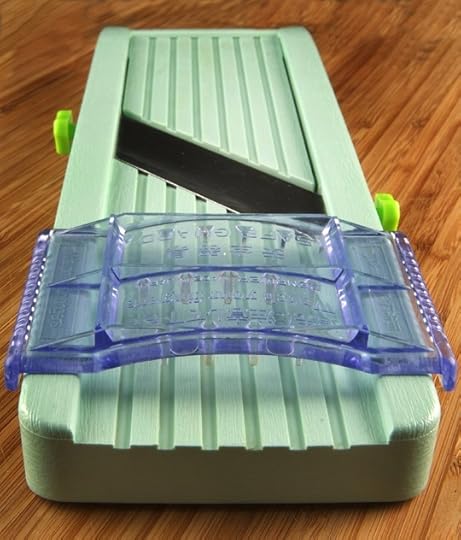
A great gift for the season. Photo by Donna Turner Ruhlman.
This is a revised post from last year with one key difference being that my mandoline, above, is in need of replacing and so I am hoping that the photographer of the image can take a hint.
Continuing holiday shopping week, here are my recommendations for modestly priced kitchen tools that are essentials in my kitchen. (All but one of the following links is to Amazon; I’m a part of its affiliate program—when you shop at Amazon via this site, it helps to support this site.) I own and love everything mentioned below.
The above Benriner mandoline ($25) is one of my most valued kitchen tools for uniform slicing, julienning, and making brunoise (a julienne turned into a dice). By far my most valuable electric device in my kitchen is the hand blender—I use Braun that seems no longer unavailable, but I bought this Cuisinart version for my mom ($60) and it works well—these devices all do the job of pureeing soups and sauces, easy whisking, quick mayonnaise, and I make vinaigrettes in the cup attachment, which will even emulsify a great Caesar dressing will pureeing the garlic. The hand blender is one of my most-used electrically powered tools.
Every kitchen needs a scale: this My Weigh KD8000 ($36) has been my go-to scale for years. Using a scale is the most reliable way of measuring, especially if you’re baking (which is why more cookbooks are including, if not leading with, metric weights, as does the ground-breaking Bouchon Bakery cookbook ($33)—another lovely gift, come to think of it!). I use two, the KD8000 for pounds of flour, say, and this pocket scale ($9) for small amounts, such as 3 grams of yeast.
An instant-read digital thermometer is a must. The professionals go for the Thermapen ($96), but there are less expensive one, such as this from my friends at Le Creeuset ($24).
For measuring temps of roasts in the oven or on the grill, a cable thermometer is a great asset. I’ve been using this RediCheck cable thermometer ($24) for years and love it. When I cook the roast beast this Christmas, the meat will have a cable thermometer in it and an alarm will go off when it reaches 120˚F to tell me I need to pay attention.
People often ask for knife sharpening recommendations. I get my knives sharpened professionally a couple times a year, and I maintain their edges with DMT sharpening “stone,” actually a diamond coated perforated metal sheet. At more than $100 depending on your needs, it’s more in the higher price range but I wanted to mention it.
Every kitchen needs a good pepper grinder for freshly ground pepper that, importantly, doesn’t grind too coarsely; you need a mill for fine grinding, and Peugeot’s are excellent ($55), the usual choice in the professional kitchen.
Can’t forget the Microplane, a real game changer when the company (which originally created them for woodworking) introduced models for the kitchen, for all manner of zesting and grating.
I love my fluted pastry wheel for making decorative edges to pastries, and lattice pies. Disposable pastry bags are a great inexpensive gift.
And last but not least, while I’m wary of what Alton Brown calls the unitasker, the kitchen tool that does only one thing, I would be very sad to lose this lemon juicer. Fresh lemon and lime juice are always in play in my kitchen and this baby makes juicing the work of a moment. Worth the $10? Yeah.
For stocking stuffers, a plastic bench scraper ($4). Seriously. It’s one of my most reached for tools in the kitchen, mainly for transferring chopped food into hot pans. It’s one Michael Symon’s favorite tools. When I did The Chew last week, there it was on his cutting board. Another stocking stuffer, for those literary cooks and aspiring food writers, my Kindle Single, about how I accidentally wound up writing about food and cooking, a short memoir called The Main Dish ($2).
Cooking is a craft, and good tools are a must with any craft.
© 2013 Michael Ruhlman. Photo © 2013 Donna Turner Ruhlman. All rights reserved.
December 2, 2013
Cyber Monday: 50% Off All Dalton-Ruhlman Tools!!!
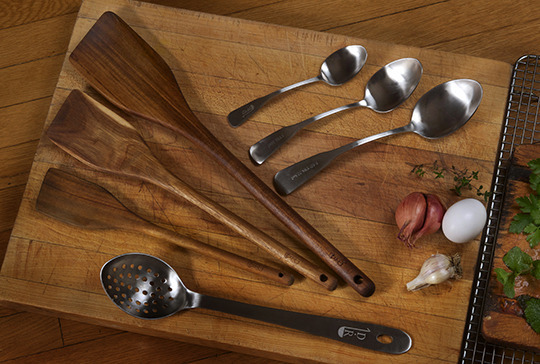
Tool bundle. Photo by Donna Turner Ruhlman.
Hard to believe it’s been three years since my friend Mac Dalton and I introduced a small line of cooking tools. They’ve gotten kudos from chefs such as David Kinch and Jonathon Sawyer to Martha herself (she actually placed an order through my site). We haven’t advertised these things, we haven’t done any merchandising, because, well, that work gives me a headache, just not my thing, and there’s too much fun stuff to do, like actually making things. That’s what I love.
To promote these tools, which I love and am proud of (except for the bamboo cheese set, which Mac adores, why, I have no idea, but they sell, go figure), we are offering, and here’s my stab at promotion and merchandising, 50% OFF ALL ITEMS DURING CYBER MONDAY!!!! (Seriously. Why four exclamation points? BECAUSE THAT’S WHAT AN INCREDIBLE DEAL IT IS!)
Again: Click on this link and use the code word gobble to get your discount.
My personal faves are The Badass Perforated (aka Egg) Spoon, the mighty Spanker, the offset spoons, and the little-known but awesome in-drawer bamboo knife holder—seriously love this thing.
And as far as gifts go, the above-pictured bundle tool cannot be beat. By anything. At 50% off less than $30. Emilia, can this be right? Are you sure we should be doing this?
All the tools are fabulous. One day only. Code word: gobble, case sensitive, all lowercase.
Happy shopping!
This is not only the best all-purpose perforated spoon on the market, it also helps you create perfect poached and fried eggs.
All-Strain reusable straining cloths for everything from stock to tomato water to Greek-style yogurt to cheese. The world doesn’t need more stupid kitchen tools (banana slicer?! egg separator?!—see my video below).
I love a well-made THICK quiche. Recipe here for a classic Quiche Loraine. Happy shopping and happy cooking!
If you liked this post check out these other links:
My video post on Stupid Kitchen Tools.
Follow me on social media: Facebook and Twitter.
© 2013 Michael Ruhlman. Photo © 2013 Donna Turner Ruhlman. All rights reserved.
November 29, 2013
Shopping: Big Ticket Items

Lamb braising in my Le Creuset Dutch oven, which is a fantastic gift to give that special someone. Photo by Donna Turner Ruhlman.
This is the big ticket recommendations from last year because, well, the best equipment doesn’t change. Hope everyone had a happy and festive thanksgiving!
It’s time again for my picks for the big-ticket items, those expensive appliances and pots that are game changers, but real investments.
I’ve just started a relationship with Le Creuset, the company that makes the best enameled cast-iron cookware on earth. My go-to pot is the 7-quart Dutch Oven (they’re made in France and the company wants me to call them French ovens, which I find interesting since there really should no longer be a nationality attached to the thing; my preferred name for this one is “My Favorite Pot”). It’s what I bought my beloved Dad long ago; now, sadly, I have two of them. My other favorite is the braiser, the everyday pot in which you can cook just about anything. (Here’s one of the videos we did, where I use this pot to make an easy cassoulet.) I’m also partial to the smaller “ovens”—the 3.5-quart version is perfect if you cook for only one or two people.
For stainless-steel cookware, All-Clad is the best, and they aren’t paying me to say so. Here are their saucepans, plus a big sauté pan and a small one. My favorite All-Clad pan is the saucier.
I recommend these Wusthof knives. You don’t need a ton of knives, but you need at least two: a chef knife (big) and a paring knife (small). A serrated knife comes in handy for slicing bread, and a flexible boning knife is helpful if you do a lot of cutting.
The Vitamix blender is an awesome machine.
The KitchenAid stand mixer. Far more important than a food processor, this is the workhorse in my kitchen.
Here’s the food processor I used to use, but the lid broke so now I have to turn it on manually and put a plate on top, which is kind of a pain. In professional kitchens, all the food processors are Robot-Coupes. They’re great, and until their marketing company contacted me and sent me one to try, I didn’t know they made one for the home kitchen. They do, it’s called a Magimix 3200, and while I don’t like the name, it’s a fabulous machine, with three different-sized bowls. Alas, available only at Williams-Sonoma.
The iPad2 and Kindle Fire HD are going to be game changers in the kitchen. These are the most exciting kitchen tools to come along in a decade. If you have one already, have a look at my bread baking app (on iTunes and Kindle Fire) and also the app for smart phones called Ratio (on iTunes). I personally use Ruhlman’s Twenty on my iPad via the Kindle app: below, the finished braised lamb shank, from Twenty.
Cooking is a craft, and good tools are a must with any craft.

Braised lamb shank
© 2013 Michael Ruhlman. Photo © 2013 Donna Turner Ruhlman. All rights reserved.
November 28, 2013
Happy Thanksgiving 2013
Happy Thanksgiving all. I’m surrounded by Donna’s big lively festive brood of a family in the gorgeous Hudson Valley, and paying attention to all I have to be grateful for. I have so little to be ungrateful for–bunions, hemorrhoids, our inept Federal government–that alone is a blessing.
But this is our shared national holiday, one centered on food as a symbol of bounty and good fortune, whatever we may have or not have. It is a time above all to remember the Gascon motto: Alone we die, together we thrive.
It is also a time to remember that food is not simply our body’s fuel, an occasional luxury, or a daily errand, but rather the anchor of our lives without which we perish. It is what binds or families and our communities. It demands that we work together and share in that work. To take care of our food is to take care of our families and the community we are necessarily a part of.
Alone we die, together we thrive.
I’m wishing all friends and family and the generous readers of this blog a happy Thanksgiving and hoping you are with the people you most cherish, cooking all day, and soon sit before a bountiful table to give thanks.
Michael Ruhlman's Blog
- Michael Ruhlman's profile
- 354 followers


